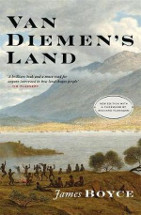Van Diemen's Land by James Boyce

Black Inc., 2008, new edition 2018. ISBN 9781760640781
(Age: Senior Secondary - Adult) Highly recommended. This award
winning book has recently been republished with a foreword by
Richard Flanagan.
James Boyce has written an enlightening early 'environmental'
history of Van Diemen's Land which shows how the convicts were
changed by the land and people they encountered. Instead of an arid
wilderness beset by the kinds of problems encountered in early
Sydney, the new inhabitants found an abundance of wildlife in the
form of the Forester kangaroo and emu. Within 2 years of settlement
convicts were able to live independently in the bush using nothing
more than a hunting dog.
'They soon turned to native animal skin for their clothing and
pretty soon they adapted aboriginal designs and learnt how to build
overnight shelters very quickly and later, stronger huts. So
basically, all of the essentials of life they were able to access
from the bush around them. If you think of the poor of Britain you
can imagine how tough life was for them in the early 19th century.
Fresh meat was a very occasional luxury and even wheat, bread was
very expensive. Genuine material poverty - so for the convicts that
came here to be able to access the essentials of life - food,
clothing, shelter, independently was an enormous boon.'
In the 1820s relations between Europeans and Aboriginal people in
central Tasmania, began to change as almost all indigenous people
were either killed or removed, wild dog numbers exploded, fire-stick
burning ceased, emu became extinct and kangaroo numbers dwindled.
This was followed by the peak of convict influx in the late 1830s
and early 1840s, including large numbers of Irish and women
convicts. The colony survived but the convict freedom and
independence was curbed as more and more free settlers arrived.
The Appendix of the book, 'Towards Genocide Government Policies on
the Aborigines 1827-38', provides a detailed examination of
Lieutenant-Governor George Arthur's horrific assault on the
Aborigines in north-west Tasmania, ending with their complete
removal to islands in Bass Strait following roundup and imprisonment
on Sarah Island in Macquarie Harbour.
The history is supported with a wide variety of primary sources and
an extensive index.
It was an engrossing book, easy to read and accompanied by a
beautiful cover using John Glover's 1834 portrait of Hobart and
Mount Wellington, as well as photographs of the changed landscape,
important identities and maps. It is also available as an ebook.
Paul Pledger